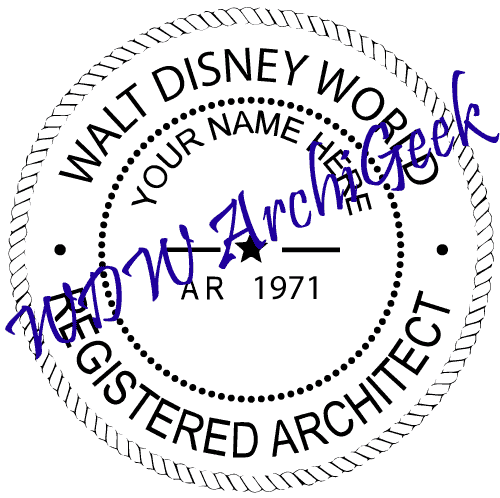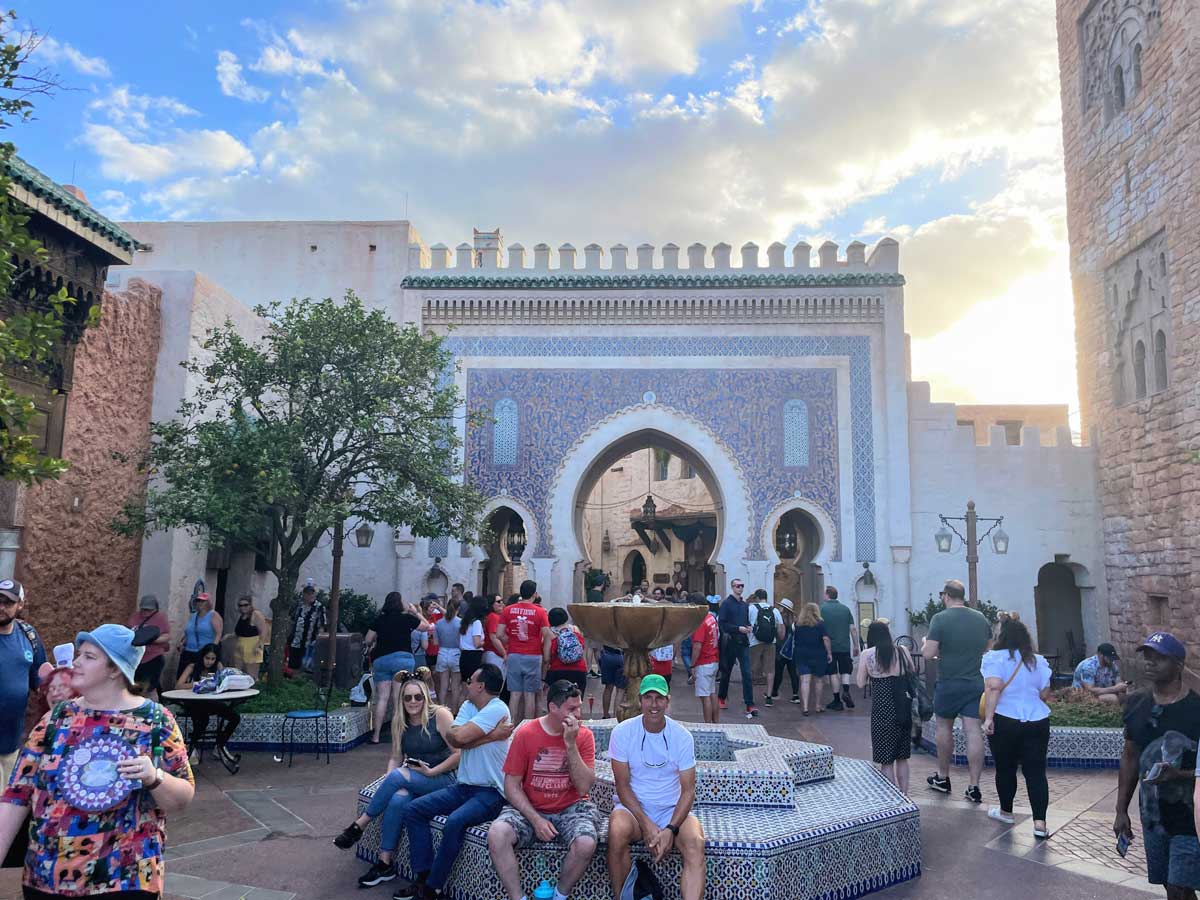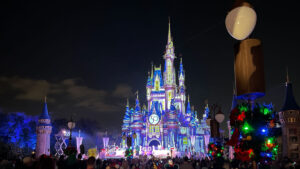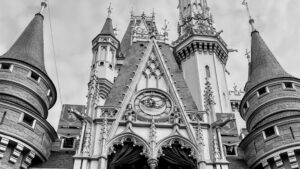It’s time to visit Epcot again. This time we’ll look at the architecture of the Bab Boujeloud Gate in Morocco at Epcot. As you stroll through the World Showcase, you’ll find the Morocco Pavilion nestled between France and Japan. The pavilion is a remarkable collaboration between the Walt Disney Imagineers and the Kingdom of Morocco, showcasing stunning architecture, intricate details, and authentic cultural elements. Stepping through the Bab Boujeloud Gate, also known as the Fez Gate, is like crossing a portal to the vibrant streets of a Moroccan city.
This majestic edifice separates the Morocco Pavilion into the New City and the Old City. It’s not quite the memorable landmark that some other Epcot pavilions offer. I’m thinking of the Stave Church in Norway, or the Torii Gate in Japan. But, the Moroccan Gate is still the central focus of its Pavilion. It is also a faithful replica of the gate by the same name in Fez, one of Morocco’s oldest and most culturally significant cities. We’ll look at the original in more detail later. Let’s look a little closer.
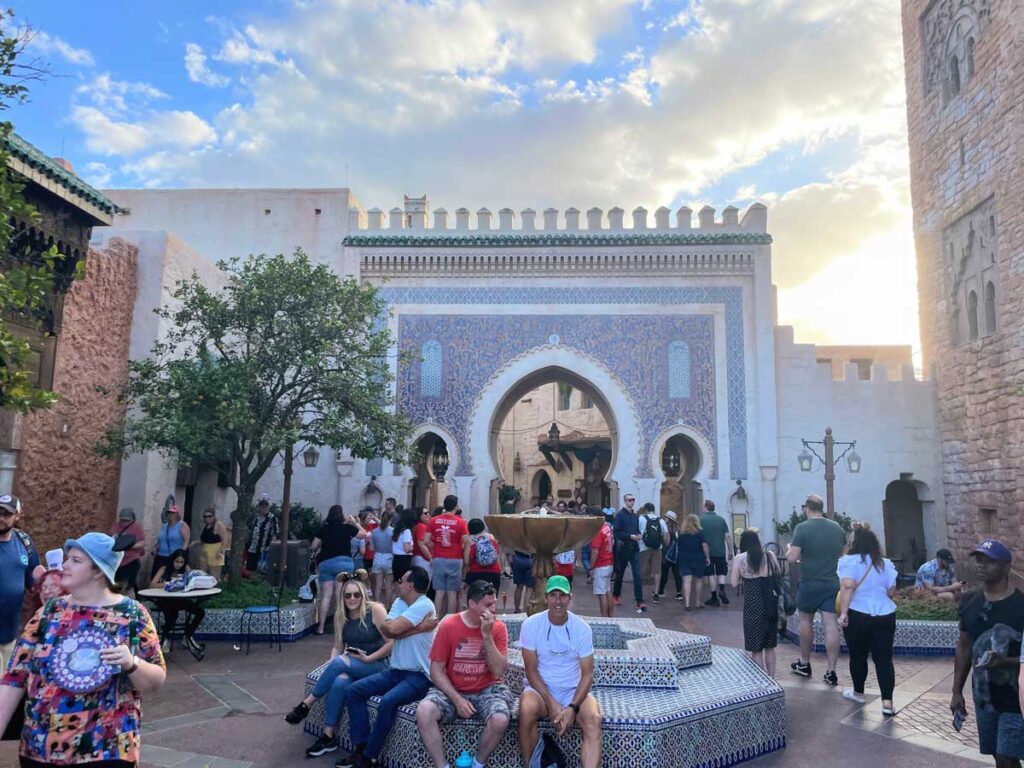
Urban Design of Morocco at Epcot
In ancient cities, city gates served as guarded entrances within the protected fortified walls surrounding the city. They were there to ensure that only desired people could enter the city. Meanwhile the gate would keep others, including invaders, out. They usually were notable pieces of architecture – presenting an impressive face to the outside world, and announcing the way in to friendly neighbors.
Like most of these gates today, they don’t serve the same function anymore. Due to the advent of gunpowder and heavy artillery, city gates like this are now essentially grand decorative monuments. But some, like Bab Boujeloud Gate in Morocco at Epcot, now separate an “inner city” from an “outer city”… An “old city”, from a “new city”.
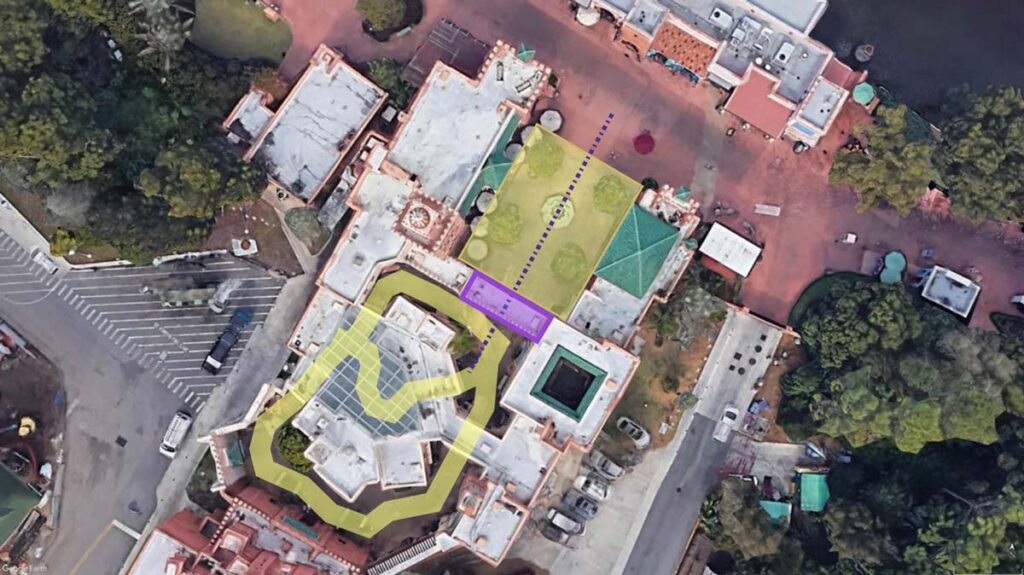
Mimicking the actual Bab Boujeloud Gate in Morocco, the example at Epcot forms a threshold between what the “new city” closest to the World Showcase Promenade, and the “old city” of the Pavilion beyond. This is reinforced in the design and atmosphere of these two different sections of the Pavilion. It’s more formal outside the gate, and quaint inside.
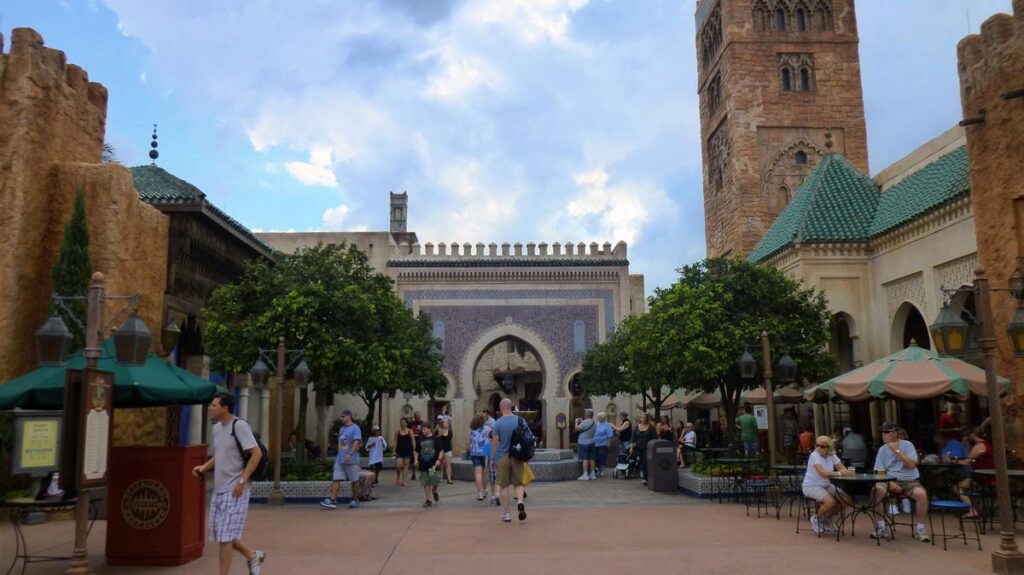
Epcot’s Morocco – New City
The “New City” is organized around a regular-shaped plaza that presents itself as more formal. A strong visual axis runs through the middle of the plaza terminating in the center of the Gate. There is a fountain in the center of the space. Citrus trees sit within beautifully-tiled planters. The plaza is well-crafted, refined and filled with symmetry.
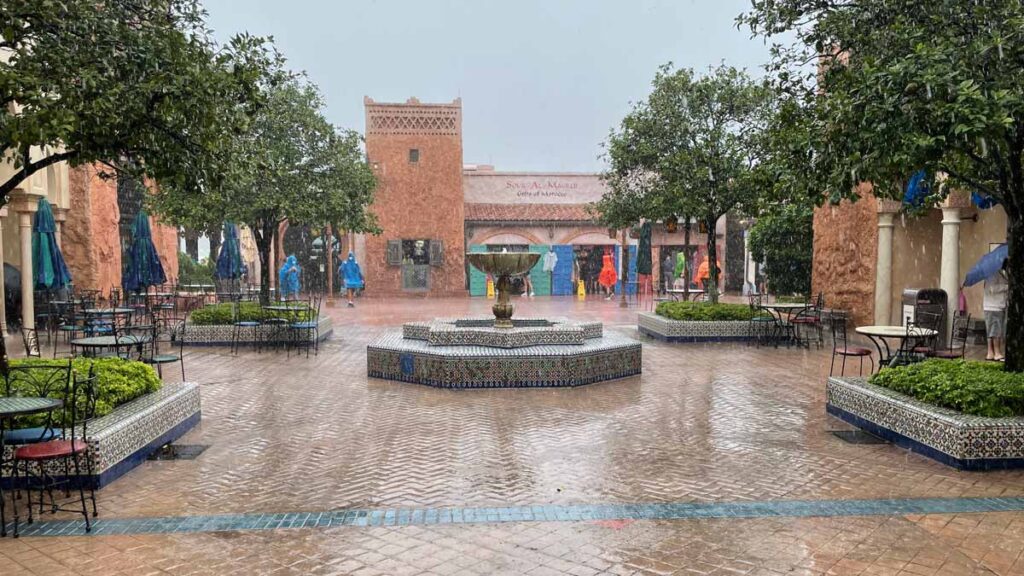
You can see the symmetry even better in the above photo… if you can see between the raindrops.
Epcot’s Morocco – Old City
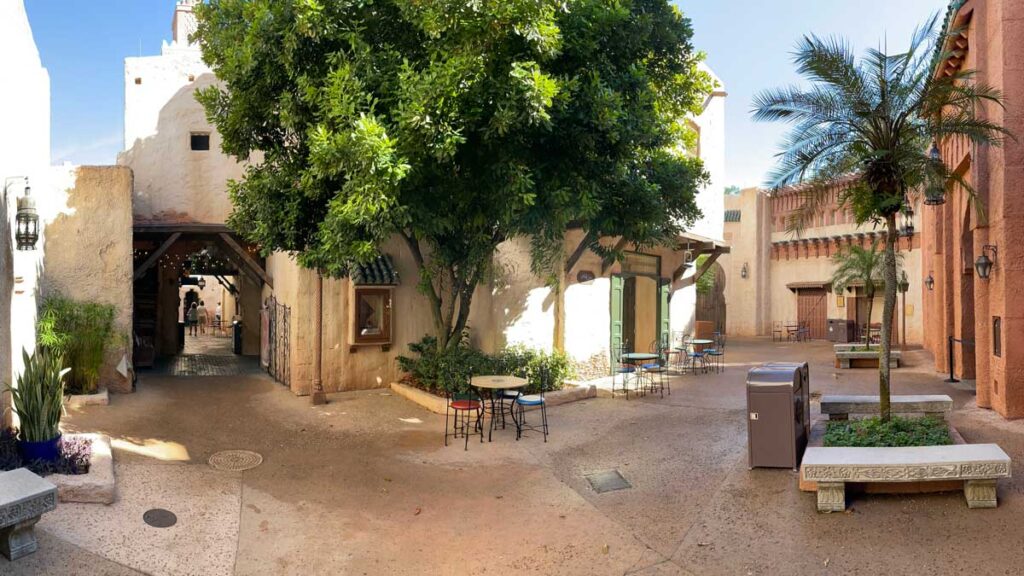
But upon passing through the Fez Gate, you are greeted by a bustling Moroccan marketplace, known as a “souk.” This the “old city”. In stark contrast to the formal plaza on the other side of the Gate, here the space is quite different. In the old city, you find a meandering series of streets and idiosyncratic spaces.
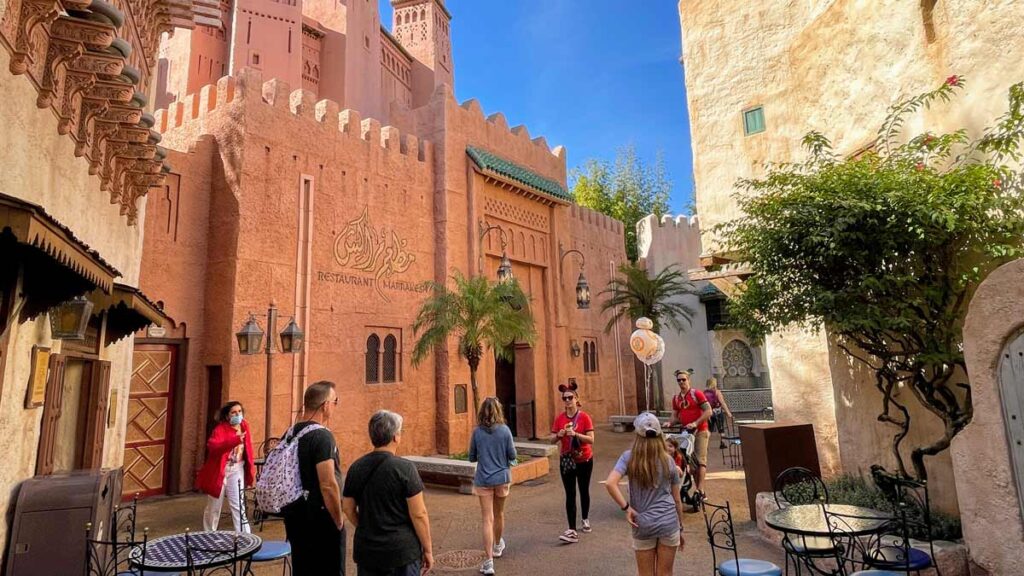
Imagineers designed the streets to mimic the narrow, winding alleys and bustling atmosphere found in traditional Moroccan cities. The sounds of street performers and the aroma of exotic spices fill the air, creating an immersive experience that transports visitors to a different world.
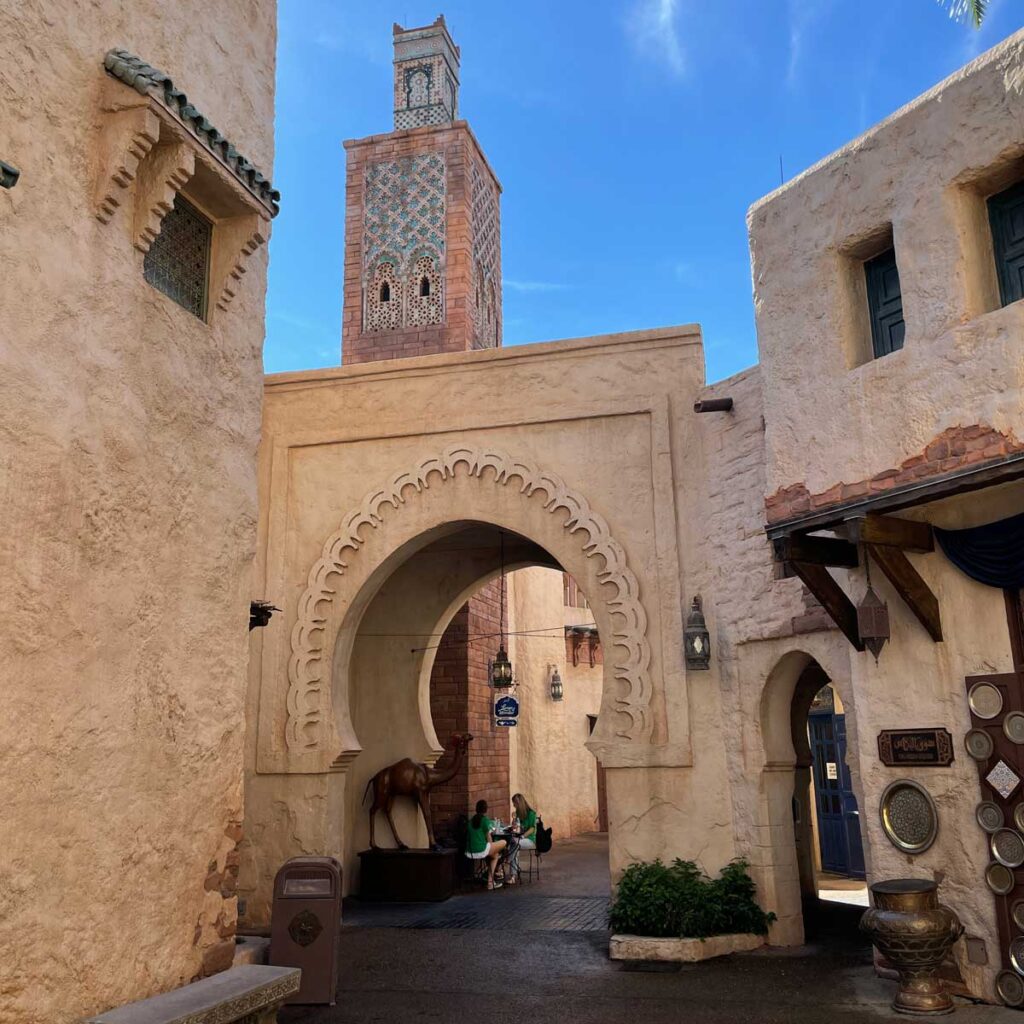
The architectural elements, including the facades of the shops and vendors’ stalls, showcase the country’s unique architectural style. This attention to detail is what makes Epcot’s World Showcase so special. It aims to provide visitors with a truly authentic cultural experience, and it delivers here in spades.
Architecture of the Bab Boujeloud Gate
So that’s what the Bab Boujeloud Gate at Epcot does from an urban planning perspective. But we want to also focus on the architecture itself. The archway features ornate tile work, traditional patterns, and striking colors, which are all characteristic of Moroccan architecture. The attention to detail is astonishing, and it serves as a testament to Disney’s commitment to authenticity.
Overall Concept
The two “faces” of the Gate (I’m getting a bit tired of writing “Bab Boujeloud”) are the same. The arches, the mosaic patterns, the colors – they’re the same on both sides of the Gate. More on that when we look at the original…
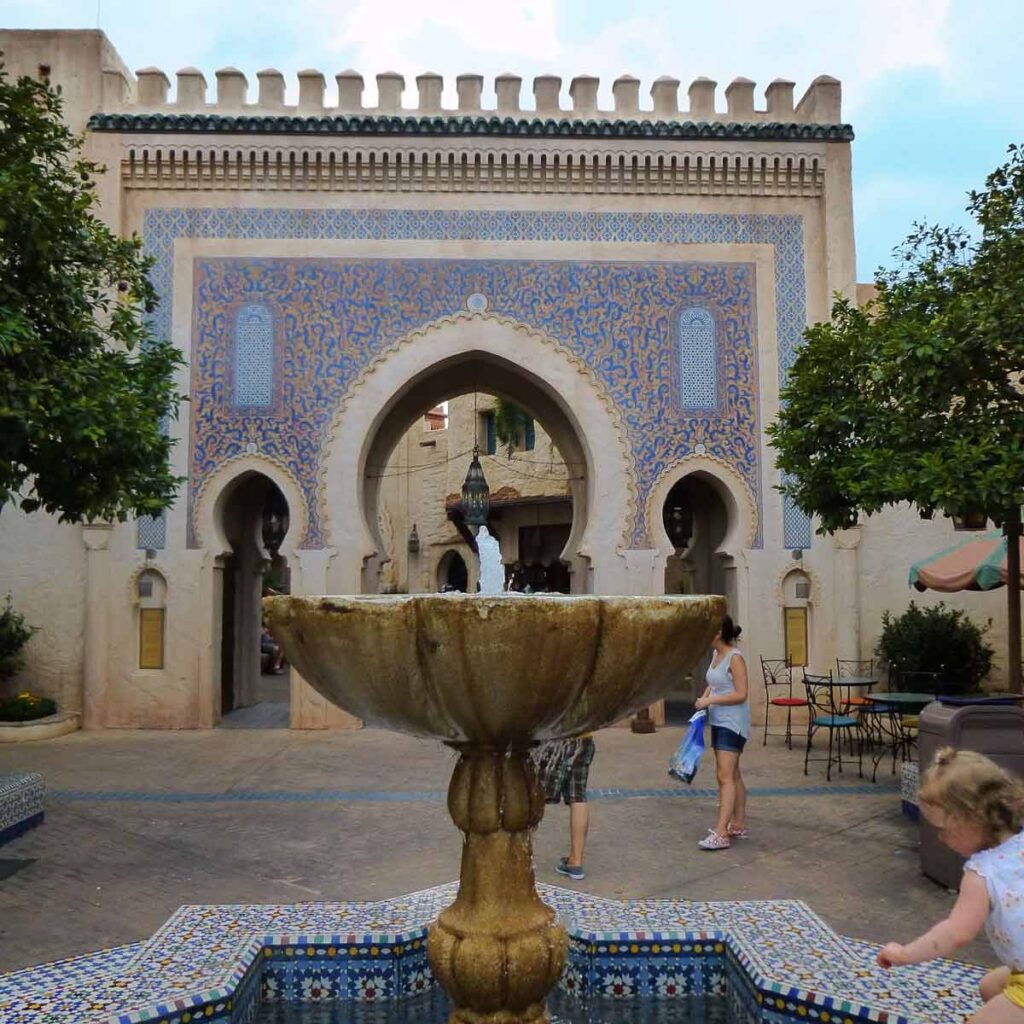
In addition, the Fez Gate itself is almost exactly a square in its proportion. I have no idea whether there’s some bigger meaning behind that, but it’s interesting. You can also see from the image above that the composition of the facade is symmetrical. It has a “frame” of sorts that is topped with a cornice-and-crenelated parapet element that provides an interesting silhouette against the Florida sky.
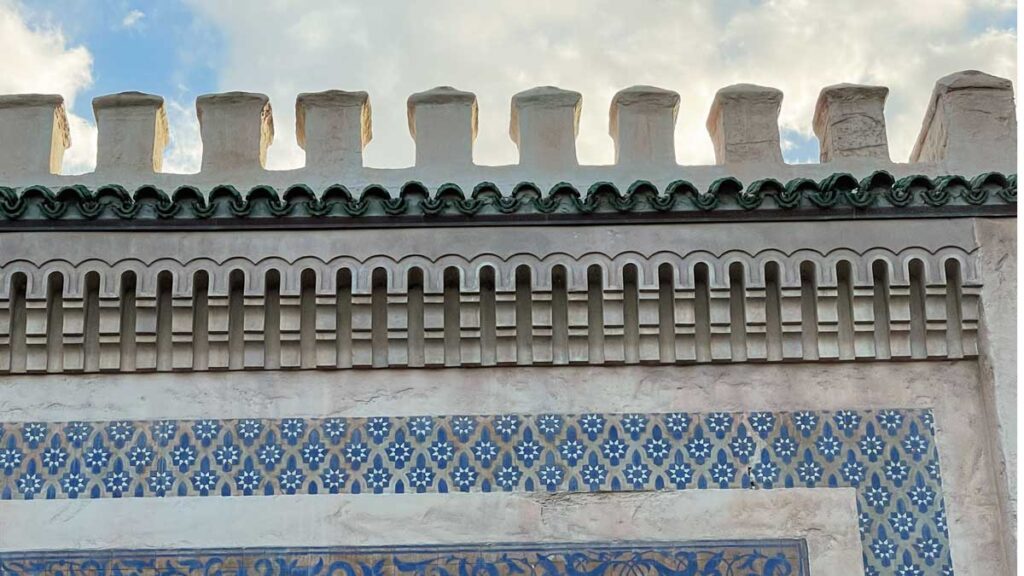
The parapet sits slightly back from the “frame”. The gap (a very small sliver of roof) is bridged by those green barrel tiles. In other words, the crenelated parapet is in the same plane as the rest of the gate inside the frame. The mini-multi-arched cornice, along with the green tiles, projects from the face of the gate, and aligns with the sides of the frame.
The Distinctive Horseshoe Arch
Maybe the the most striking feature of the Fez Gate is its horseshoe-shaped arch, a trademark of Moroccan architecture. The horseshoe arch design is reminiscent of the Moorish and Islamic influences that have shaped Moroccan architectural traditions for centuries. “Horseshoe arch?” you say. Well, thanks for asking. This blog does attempt to educate, as well as entertain, after all.
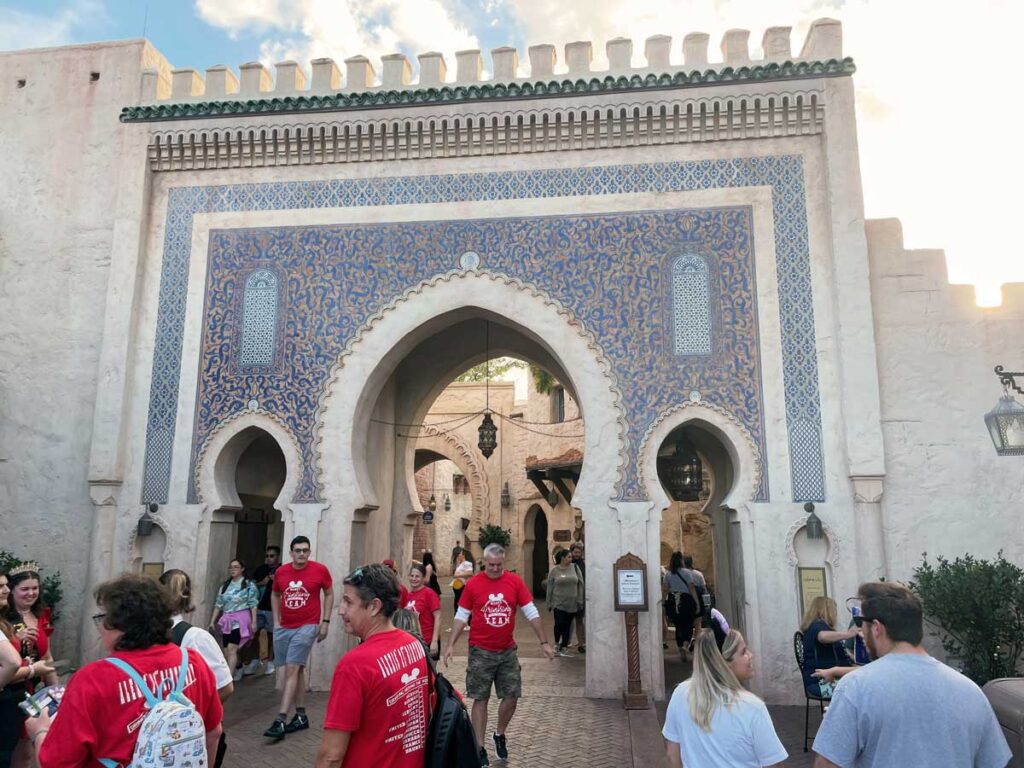
A horseshoe arch, also known fittingly as a “Moorish arch”, is an arch where the circular curve continues below the horizontal line of its diameter. Therefore the bottom of the arch – the “spring line” is narrower than the widest point of the arch. To be totally accurate, the Fez Gate’s arch is a “pointed horseshoe arch” for obvious reasons. The top of the arch culminates in a point, as opposed to a continuous curve.
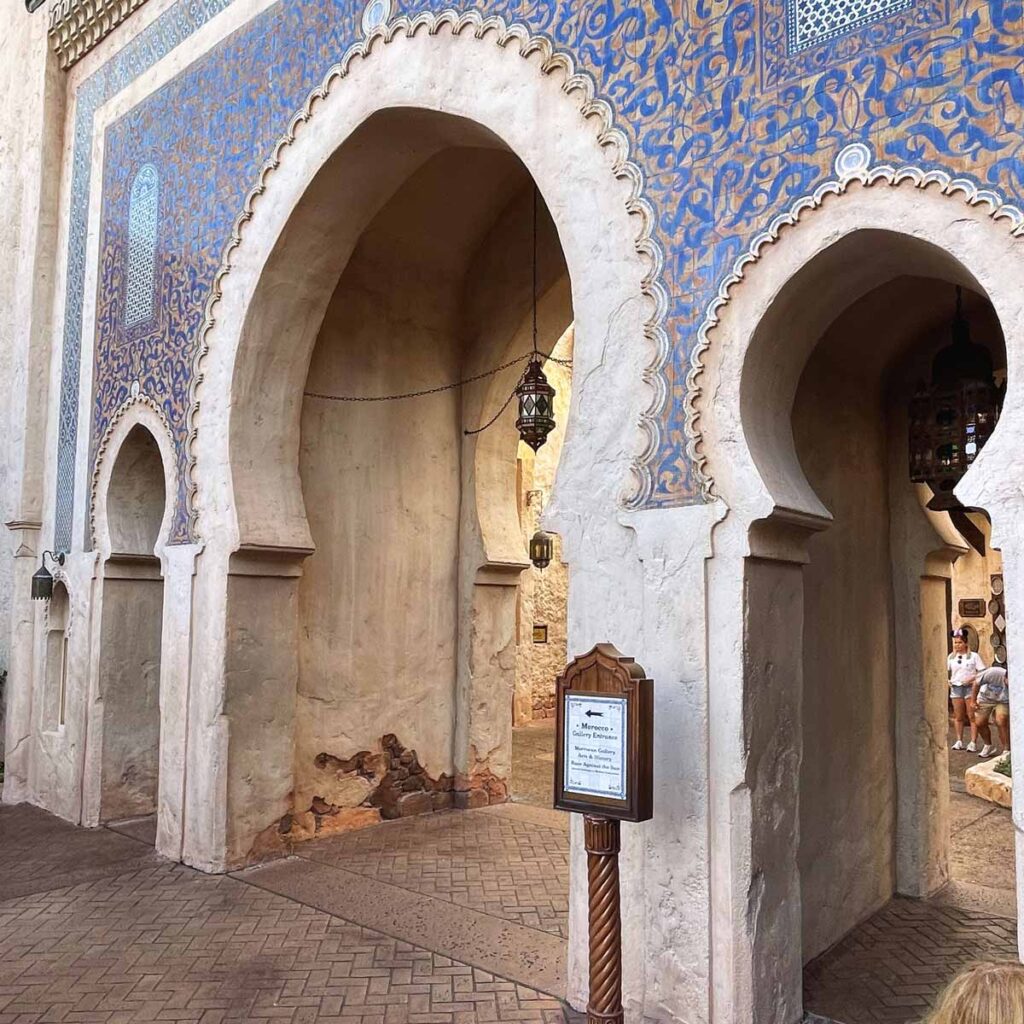
The three arches all share the same spring line – the point at which the arch rises above its vertical support. However, the central arch stands wider and taller, even though its proportional to the smaller flanking arches. You can see in the image above that the arches themselves are a few feet thick. Walls with vaulted ceilings connect the arches on the two faces.
The three arches have three light fixtures within them – each of them unique. The central arch has a lamp suspended between four chains in the middle of the space, while the two smaller arches have beautiful lamps hanging directly down from the ceiling.
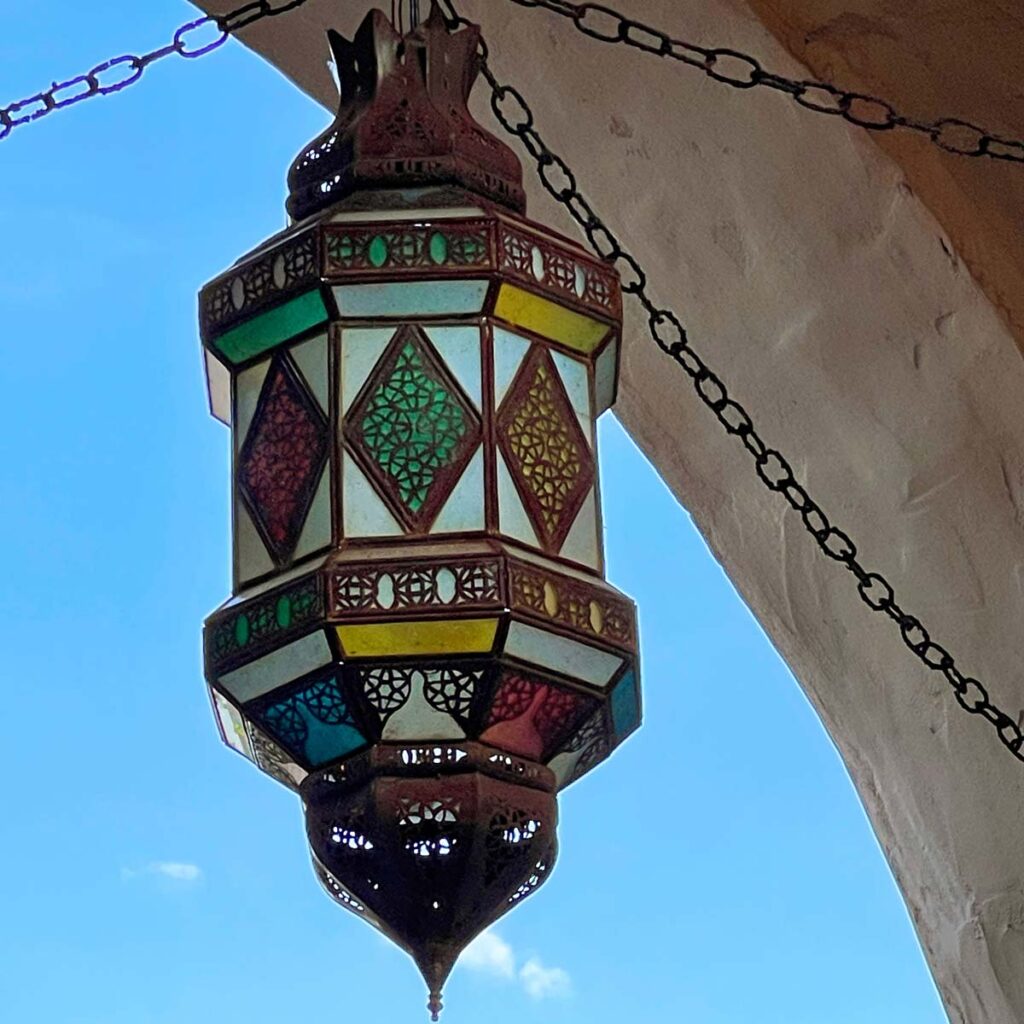
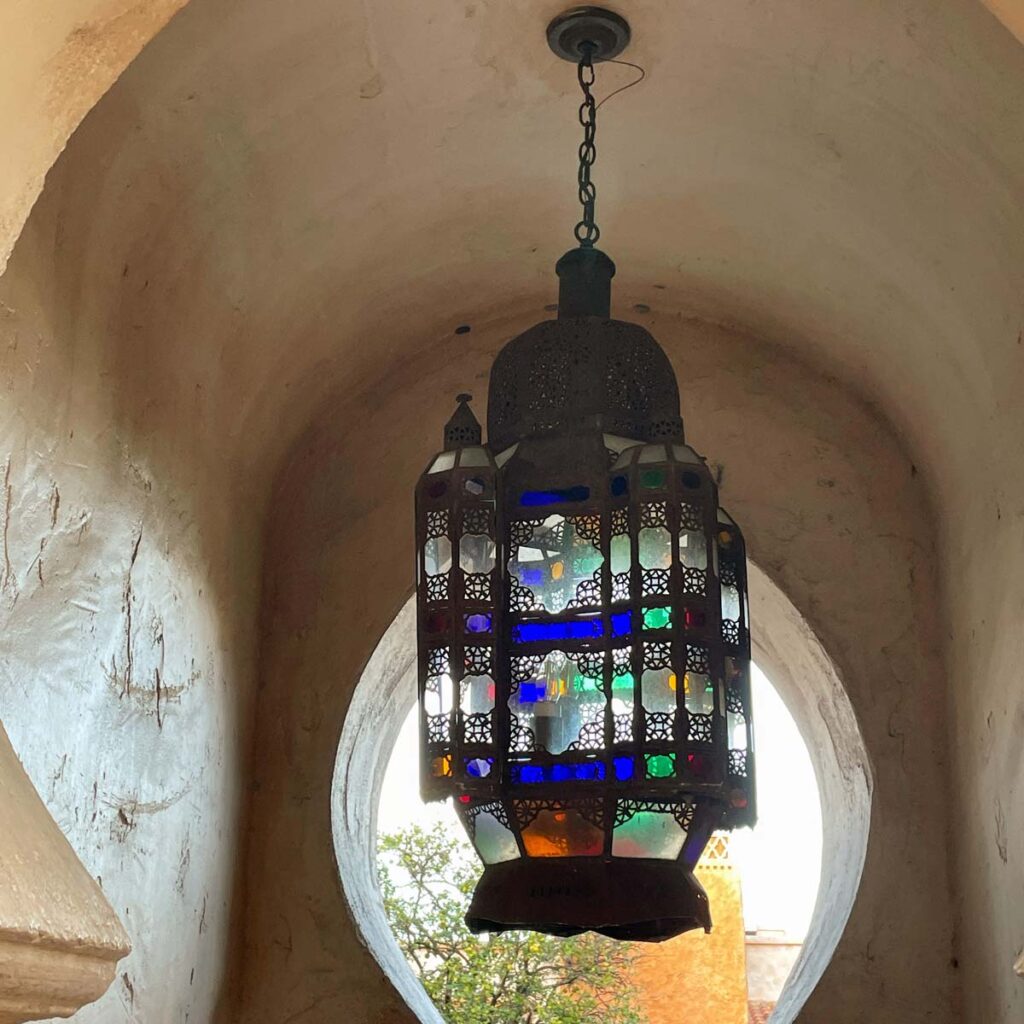
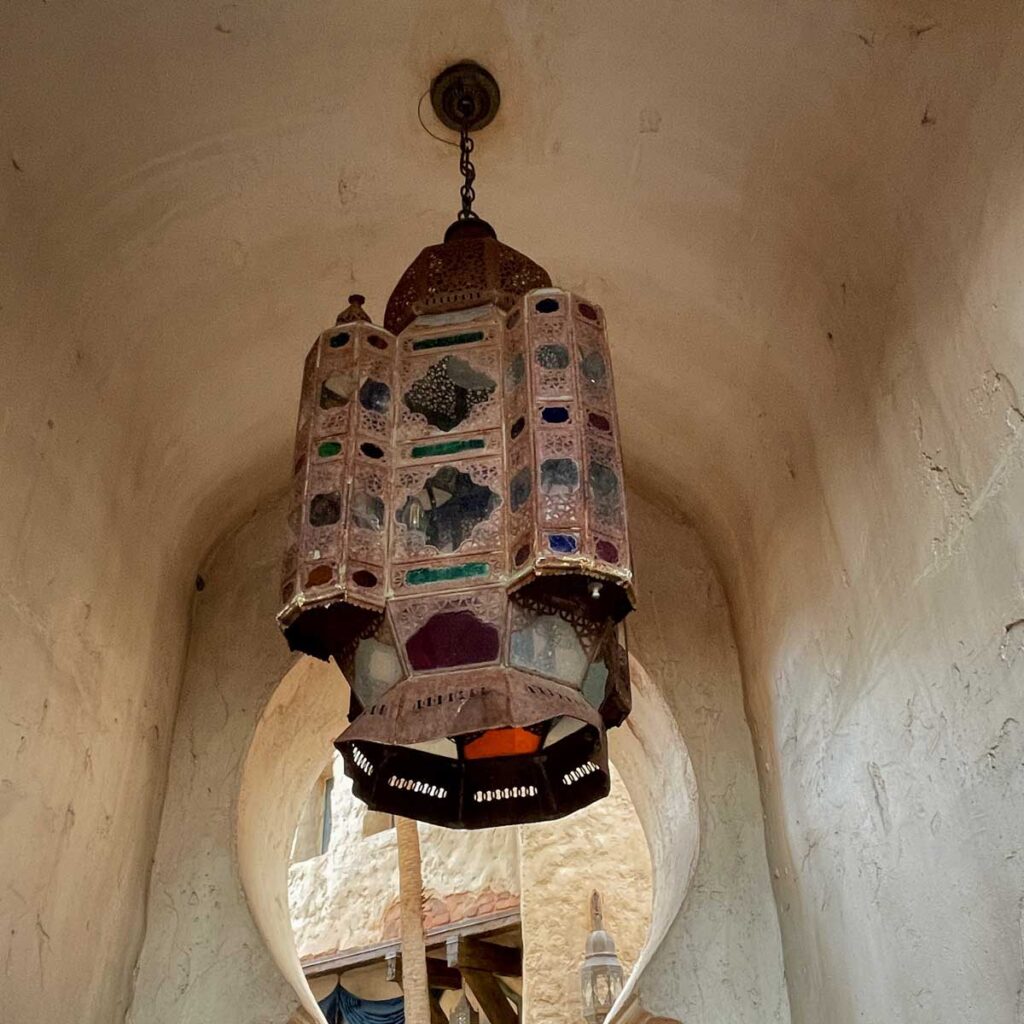
Ornate Tilework
Apart from the overall massing and arches, the Fez Gate in Epcot’s Morocco’s decorative finishes are also a showcase of Moroccan artistry.
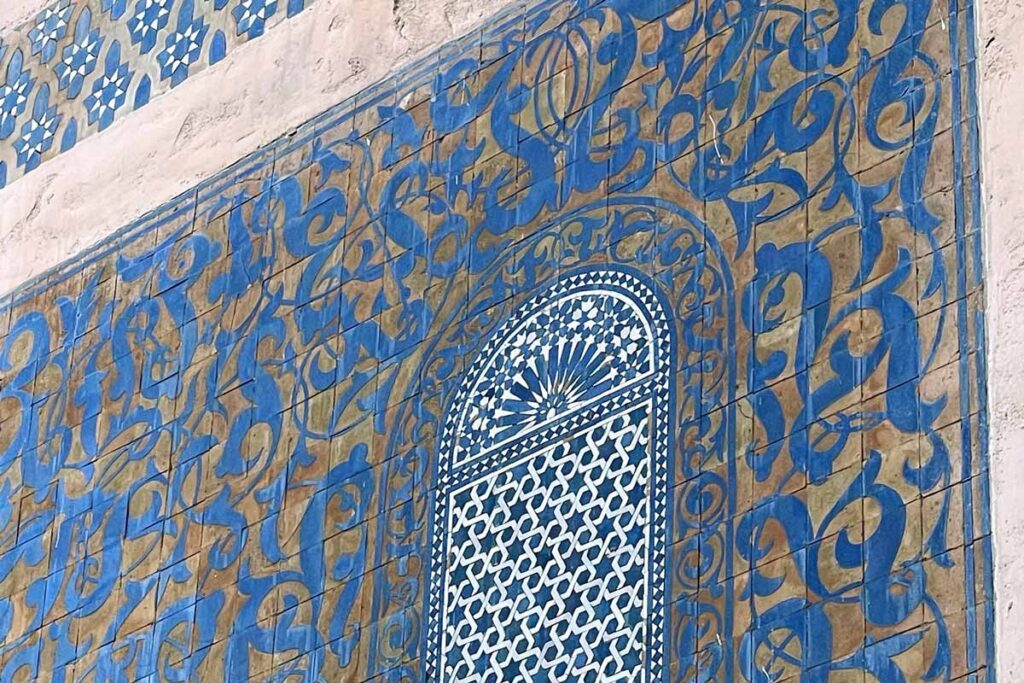
The arch is adorned with stunning zellij – mosaic tilework that showcases elaborate geometric patterns and vivid colors. The façades on both faces of the Gate features an array of vibrant hues, including deep blues, emerald greens, and earthy tones. The intricate tile patterns showcase the talent and craftsmanship of Moroccan artisans, celebrating the country’s rich artistic heritage.
I love how the sunlight changes the appearance of the two sides of the Fez Gate – especially in the late afternoon and evening. The side facing the Showcase Lagoon, the north side, doesn’t get direct light from the sun. And so the colors of the tilework appear to be a cooler tone. Compare this to the south-facing facade of the Gate, which faces the souk and the portion of the Morocco pavilion that represents the older city. The warm sunlight causes this side of the Bab Boujeloud Gate to take on warmer color tones. See below for a comparison:

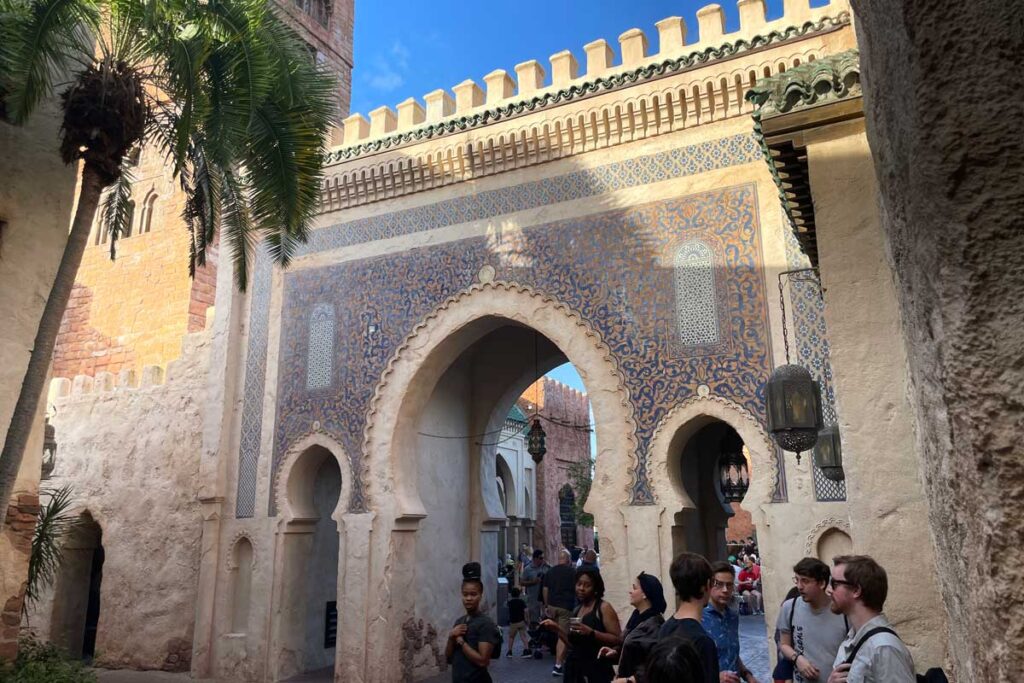
These pictures are from the same day in the late afternoon. Beautiful!
Historical Precedent – The Blue Gate in Fez
Let’s close by taking an architecture-focused look at the inspiration for the Fez Gate at the Morocco Pavilion at Epcot. As opposed to many other Walt Disney World structures, this one is essentially a facsimile of its source material.
Bab Boujeloud: A Cultural Landmark
Bab Boujeloud, also known as the Blue Gate, dates back to the 12th century, when it was built as a simple and modest gate to protect and regulate access to the old city of Fez, Morocco. The name Boujeloud means “Father of the troops” in Arabic, and refers to a military square or parade ground near the gate. The gate was also close to two important citadels.
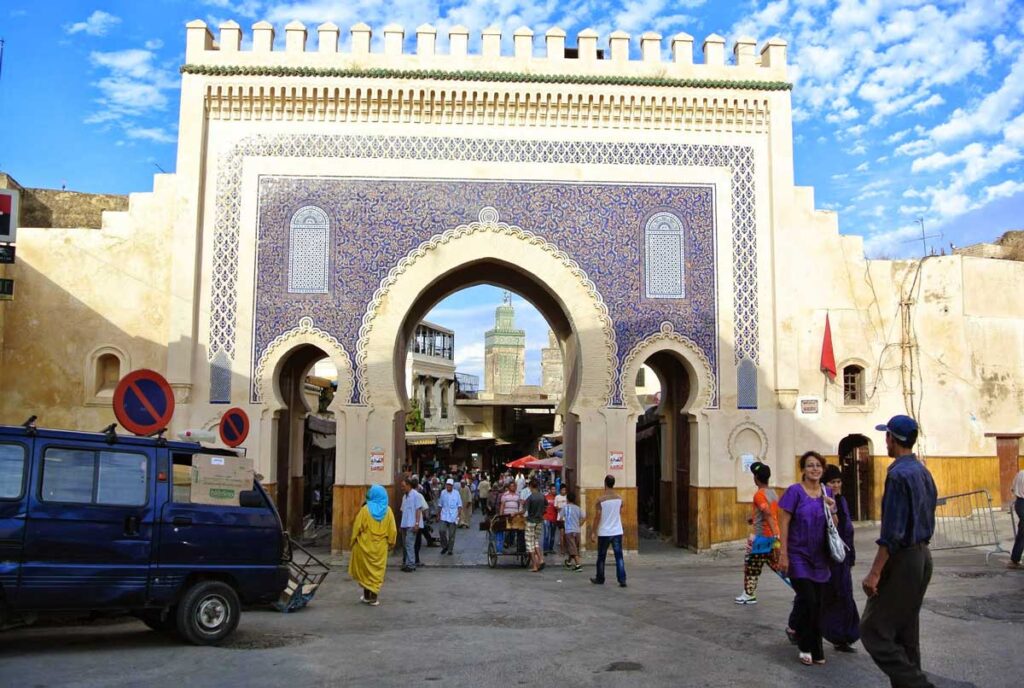
The original gate is still visible today, but it is closed off and overshadowed by the monumental gate that was built by the French colonial administration in 1913. The French wanted a grander entrance to the old city, and designed the new gate to emulate Moroccan architecture.
Bab Boujeloud is not only a beautiful structure, but also a cultural landmark that reflects the history and identity of Fez. Just like Epcot’s version, it stands between the new and old portions of the city of Fes el-Bali, which is one of the largest and oldest medieval cities in the world, and a UNESCO World Heritage Site. The gate is also a popular meeting place for locals and tourists alike, who gather around the gate to enjoy its beauty and atmosphere. It is surrounded by cafes, restaurants, shops, and hotels, offering a variety of options for visitors, and even hosting cultural events and festivals.
Bab Boujeloud: Architecture
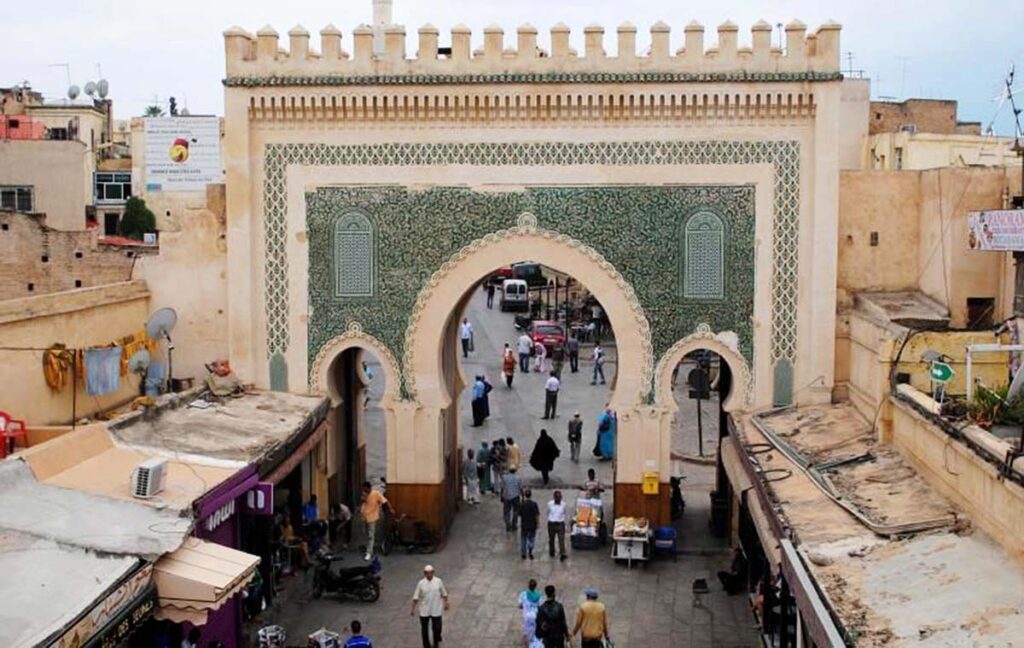
The new gate is a masterpiece of Moroccan architecture, and is decorated with blue tiles on the outside and green tiles on the inside, representing the colors of Fez and Islam respectively. These two separate color palettes is one of the few clear differences between the Morocco and Epcot versions. The use of zellij is an essential element of Moroccan architecture and design. The tiles are arranged in various shapes and motifs, such as stars, flowers, and arabesques. These geometric patterns and floral motifs exude a sense of harmony and unity, showcasing the incredible craftsmanship that has been passed down through generations. The gate also features carved inscriptions in Arabic calligraphy, as well as decorative elements such as arches, columns, and niches.
Bab Boujeloud’s most striking feature is undoubtedly its horseshoe-shaped arch, which dominates the gate’s facade. As mentioned, the use of the horseshoe arch (ahem… pointed horseshoe arch, see above) is characteristic of Moroccan architecture, influenced by Islamic, Andalusian, and Moorish styles.
Conclusion
It’s pretty obvious from the above images that Disney created what is almost an exact replica of this gate in Morocco. There are surely small differences, but even the tilework motifs, and the number of parapet crenelations, and the small barrel-tile cornice are all repeated in Epcot’s version.
The Fez Gate, or Bab Boujeloud Gate, in the Morocco Pavilion at Epcot is another wonderful example of the immersive way Disney World’s architecture can transport you to another place. The Gate’s faithfulness to Moroccan architecture really roots the entire Pavilion in authenticity. Walking through the Gate to explore the “old city” is one of my favorite experiences in Epcot. I’ll give it the stamp of approval.
